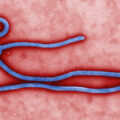

Ebola and Flu Season – Dangerous Combination
 The Ebola virus is present in blood, saliva, mucous, vomit, feces, sweat, tears, breast milk, urine, nasal secretions, and semen. It can live for several hours on common services like door handles and clothing. It can survive for several days within body fluids such as blood. Ebola’s primary symptoms include fever greater than 101.5°F, severe headache, muscle pain, weakness, diarrhea, vomiting, abdominal cramping, and unexplained bleeding or bruising. Nasal congestion cough, upper respiratory, and lower respiratory symptoms are not normally seen within Ebola infection. However, if the patient does have a cough or sneezes; their nasal secretions or saliva can become airborne. Particles launched via cough and/or sneeze generally travels 3 feet or more. Fortunately this is not a common method of transmission of the Ebola virus, but the possibility needs to be taken into consideration.
The Ebola virus is present in blood, saliva, mucous, vomit, feces, sweat, tears, breast milk, urine, nasal secretions, and semen. It can live for several hours on common services like door handles and clothing. It can survive for several days within body fluids such as blood. Ebola’s primary symptoms include fever greater than 101.5°F, severe headache, muscle pain, weakness, diarrhea, vomiting, abdominal cramping, and unexplained bleeding or bruising. Nasal congestion cough, upper respiratory, and lower respiratory symptoms are not normally seen within Ebola infection. However, if the patient does have a cough or sneezes; their nasal secretions or saliva can become airborne. Particles launched via cough and/or sneeze generally travels 3 feet or more. Fortunately this is not a common method of transmission of the Ebola virus, but the possibility needs to be taken into consideration.
Patients with Ebola are just as likely as anyone else to develop upper respiratory infections caused by other viruses and to develop allergic symptoms. Both of these will of course cause the patient to cough and sneeze, and to have increased nasal discharges. In essence the patients could place those who are nearby at risk for receiving the Ebola virus in particles that are transmitted via the air. If the patient has the simultaneous onset of Ebola symptoms combined with flulike symptoms they may also not seek attention, as they may assume that their symptoms are tied to the upper respiratory infection alone. While these combination of events are not extremely likely, certain times of the year feature increased incidences of upper respiratory viral syndromes, including areas where Ebola is prevalent.
For this reason, during flu season, the risk of Ebola spreading could potentially increase. Individuals who live in, or travel to areas where Ebola is prevalent need to consider the possibility that they could be infected by individuals who are demonstrating flulike symptoms. If they develop symptoms within 21 days of potentially being exposed, even if these symptoms are not classic for Ebola, they need to seek immediate medical attention and to take also possible precautions that could prevent it from spreading to others. Health practitioners also need to have heightened awareness that patients at risk due to potential exposure who present with respiratory symptoms need to be treated with particular care. Patient harboring the Ebola infection and afflicted with the common cold, could in theory pose a significant public health challenge.
Additional Sources of Information on Ebola:
Assessment of the Risk of Ebola Virus Transmission from Bodily Fluids and Fomites
Largest Ever Ebola outbreak is not a global threat







Really pleased that I found this blog. It is very informative and well written. Keep up the great work!